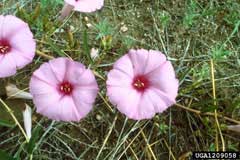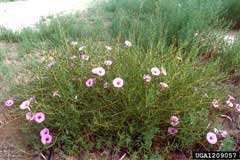 |
|
Dave Powell, USDA Forest Service, United States |
 |
| Dave Powell, USDA Forest Service, United States |
Translate this page:
Summary
Physical Characteristics

 Ipomoea leptophylla is a PERENNIAL growing to 1.2 m (4ft).
Ipomoea leptophylla is a PERENNIAL growing to 1.2 m (4ft).
See above for USDA hardiness. It is hardy to UK zone 9. The species is hermaphrodite (has both male and female organs).
Suitable for: light (sandy), medium (loamy) and heavy (clay) soils and prefers well-drained soil. Suitable pH: mildly acid, neutral and basic (mildly alkaline) soils. It cannot grow in the shade. It prefers moist soil.
UK Hardiness Map
US Hardiness Map
Synonyms
Plant Habitats
Cultivated Beds;
Edible Uses
Edible Parts: Root
Edible Uses:
Root - raw or cooked. Crisp, sweet and tender[2, 46, 61, 85]. Some reports suggest that the root is not very nice and was only used when nothing else was available, this is probably because old roots were tried[85, 257]. Roots should be no more than 3 years old, preferably only 2[85]. The roots can be up to 1.2 metres long[2] and weigh 11 kilos[235]. This report almost certainly refers to roots older than 3 years[K].
References More on Edible Uses
Medicinal Uses
Plants For A Future can not take any responsibility for any adverse effects from the use of plants. Always seek advice from a professional before using a plant medicinally.
Cardiac Miscellany Salve Stomachic
This plant was used as a cardiac stimulant by some native North American Indian tribes[213]. An infusion of the staminate cones has been used as a stomach tonic[257]. The root has been scraped and eaten raw as a treatment for stomach troubles[257]. The pulverized root has been dusted onto the body as a dressing to ease pain[257].
References More on Medicinal Uses
The Bookshop: Edible Plant Books
Our Latest books on Perennial Plants For Food Forests and Permaculture Gardens in paperback or digital formats.

Edible Tropical Plants
Food Forest Plants for Hotter Conditions: 250+ Plants For Tropical Food Forests & Permaculture Gardens.
More

Edible Temperate Plants
Plants for Your Food Forest: 500 Plants for Temperate Food Forests & Permaculture Gardens.
More

More Books
PFAF have eight books available in paperback and digital formats. Browse the shop for more information.
Shop Now
Other Uses
Miscellany
Some native North American Indian tribes would use the root to store fire in the days before matches. They would start a fire in the root, wrap it up and hang it outside. It was said that the fire would keep for seven months[257].
Special Uses
Food Forest
References More on Other Uses
Cultivation details
Requires a rich well-drained soil in a warm sunny position[1]. Requires greenhouse protection in Britain[1]. A plant survived 2 winters outdoors in a pot in Cornwall before succumbing to a very wet and cold winter[K]. This does suggest that the plant is hardy enough to survive outdoors at least in the milder parts of Britain[K]. A climbing plant, supporting itself by twining around the branches of other plants[219]. For polyculture design as well as the above-ground architecture (form - tree, shrub etc. and size shown above) information on the habit and root pattern is also useful and given here if available. The plant growth habit is a clumper with limited spread [1-2]. The root pattern is tuberous with swollen potato-like roots [1-2].
References Carbon Farming Information and Carbon Sequestration Information
Temperature Converter
Type a value in the Celsius field to convert the value to Fahrenheit:
Fahrenheit:
The PFAF Bookshop
Plants For A Future have a number of books available in paperback and digital form. Book titles include Edible Plants, Edible Perennials, Edible Trees,Edible Shrubs, Woodland Gardening, and Temperate Food Forest Plants. Our new book is Food Forest Plants For Hotter Conditions (Tropical and Sub-Tropical).
Shop Now
Plant Propagation
Pre-soak the seed for 12 hours in warm water, or scarify the seed, and sow in individual pots in a greenhouse in early spring. The seed usually germinates in 1 - 3 weeks at 22°c. Plants are extremely resentful of root disturbance, even when they are quite small, and should be potted up almost as soon as they germinate[219]. Grow them on in the greenhouse for at least their first winter then plant them out into their permanent positions in late spring or early summer, after the last expected frosts. Cuttings of side shoots in a peaty soil. Layering.
Other Names
If available other names are mentioned here
Native Range
NORTHERN AMERICA: United States, Kansas, Nebraska, Oklahoma, South Dakota, Colorado, Wyoming, New Mexico, Texas,
Weed Potential
Right plant wrong place. We are currently updating this section.
Please note that a plant may be invasive in one area but may not in your area so it's worth checking.
Conservation Status
IUCN Red List of Threatened Plants Status :

Growth: S = slow M = medium F = fast. Soil: L = light (sandy) M = medium H = heavy (clay). pH: A = acid N = neutral B = basic (alkaline). Shade: F = full shade S = semi-shade N = no shade. Moisture: D = dry M = Moist We = wet Wa = water.
Now available:
Food Forest Plants for Mediterranean Conditions
350+ Perennial Plants For Mediterranean and Drier Food Forests and Permaculture Gardens.
[Paperback and eBook]
This is the third in Plants For A Future's series of plant guides for food forests tailored to
specific climate zones. Following volumes on temperate and tropical ecosystems, this book focuses
on species suited to Mediterranean conditions—regions with hot, dry summers and cool, wet winters,
often facing the added challenge of climate change.
Read More
Expert comment
Author
Torr.
Botanical References
1274
Links / References
For a list of references used on this page please go here
Readers comment